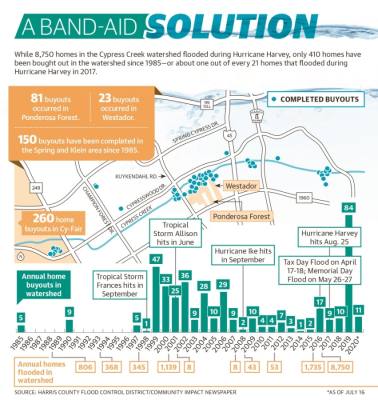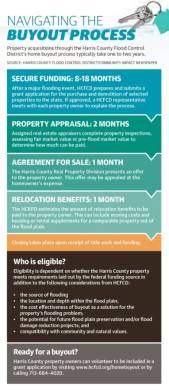Ponderosa Forest residents Lyn and Michael Jenkins were about to wrap up renovations in August 2017 to make their house one they could grow old together in—then came Hurricane Harvey.
“We had bought this place to be our forever home,” Lyn Jenkins said. “So, we were in the process of doing aging-friendly remodels, ... and we were almost to the point of completion. Then Harvey came, and we had to do it all over again.”
The Jenkins’ home was one of more than 8,750 houses in the Cypress Creek watershed that flooded during Harvey. And while the couple expressed interest in a home buyout following the flood, the Harris County Flood Control District did not.
“We never heard back from [the HCFCD], so our property wasn’t one they wanted at that time,” Jenkins said.
Since Harvey, the HCFCD has bought out 106 homes in the watershed, according to HCFCD data. Home buyout funds were included in the HCFCD’s $2.5 billion bond Harris County voters approved in August 2018. It allocated $46.8 million in local money for buyouts in the Cypress Creek watershed to help secure another $140.5 million in federal grants.
HCFCD Deputy Executive Director Matt Zeve said the district has recognized nine buyout areas of interest in the Cypress Creek watershed, meaning the district is trying to purchase those entire neighborhoods through voluntary buyouts.
“Sometimes buyouts are the best option as a flood reduction strategy ... because there is no project that will reduce the risk [of flooding] for those particular areas because they are so low in the flood plain and floodway of Cypress Creek,” Zeve said during a Houston Northwest Chamber of Commerce virtual luncheon July 16.
However, for homeowners who do qualify for buyouts, the process can be lengthy and costly, while still not addressing Cypress Creek’s chronic flooding.
A lengthy process
Since 1985, HCFCD has been buying out homes as a means of removing structures from some of the county’s most flood-prone areas, where flood damage reduction projects, such as water flow improvements or stormwater detention basins, are not options.
According to HCFCD, 60% of Harris County was developed prior to the implementation of flood plain regulations in the 1980s.
“Unfortunately, there are subdivisions that were developed prior to the system of regulations that was developed, and they were built in places where they really shouldn’t have been built,” said Jim Robertson, a member of the Cypress Creek Flood Control Coalition board of directors. “Looking back, hindsight is 2020. ... [Home buyouts] are clearly a correction [to past mistakes].”
Home buyouts can be completed through three different programs. Community Block Development Grants are funded by the U.S. Department of Housing and Urban Development, while the Federal Emergency Management Agency funds the Hazard Mitigation Grant and Flood Mitigation Assistance programs.
James Wade, HCFCD’s manager of property acquisition services, said the largest of the three is Hazard Mitigation Grant funding, which becomes available following a presidentially declared disaster. In response to Harvey, Wade said the HCFCD received $165 million in Hazard Mitigation Grant funding with a local match of $55 million for the entire county.
“The overall goal [of home buyouts] is to own every property in that neighborhood and then to remove the infrastructure, remove the streets, remove the streetlights and then turn it back into an open space,” Wade said.
While the funding programs may vary, homeowners who go through HCFCD’s home buyout program follow the same basic process.
After a property owner volunteers for a buyout, district officials determine eligibility by considering factors, including the source of the property’s flooding, its location and depth within the flood plain, the cost effectiveness of the buyout as a solution, and the potential for future preservation or flood mitigation projects. Following Harvey, Wade said 4,000 homeowners countywide volunteered for home buyouts, and only 1,100 applications were approved.
After eligible properties have been identified, it can take as long as 18 months for the district to secure funding. If the grant application is approved, a real estate appraiser assesses the property’s preflood market value and presents an offer to the homeowner.
As of July 16, 410 homes have been bought out in the Cypress Creek watershed since 1985—150 of which are located in the Spring and Klein area, according to HCFCD data. Eighty-four homes were bought out in the watershed in 2019, making it the biggest buyout year thus far. Overall, some of the most heavily targeted neighborhoods in the Spring and Klein area for buyouts have been Ponderosa Forest with 81 homes and Westador with 23. The waiting game
Upon not being eligible for the HCFCD home buyout program, the Jenkins decided to stay in Ponderosa Forest and rebuild their forever home—again.
However, for Thomas and Dwan Reed—who lived in Wimbledon Champions until Harvey flooded their home for the second time—rebuilding again was not an option.
“It was just too much, and we were really frightened that we were going to flood again,” Dwan Reed said.
Instead, as the home did not qualify for a buyout, Dwan Reed said she and her husband sold their home to an investor—a decision they soon regretted as they later found out the contract was not valid in Texas.
“People shouldn’t make a decision [like that] until at least two weeks after the incident because everyone’s in shock, and investors know that,” Dwan Reed said.
Unfortunately, Wade said this is a regular occurrence that follows natural disasters.
“When we submit the grant application, it’s usually eight to 18 months before we have that money, and typically ... people are not going to wait,” Wade said. “A lot of investors come knocking at their doors, and they’ve got money in their pocket.”
Wade said by the time the HCFCD had secured funding after Harvey, about 30% of the 1,100 homeowners whose applications had been approved for buyouts had already either sold their homes or renovated with flood insurance money.
“A lot of people don’t have the luxury of waiting,” Wade said. “I don’t know that I could wait eight to 18 months.”
By contrast, Dick Smith, who serves as the president of the Cypress Creek Flood Control Coalition, is one homeowner whose home has been successfully bought by the HCFCD. Despite his home in Cypress being elevated specifically to limit its risk of flooding, Smith said his home flooded six times between 1982 and 2017.
“After Harvey, we decided it was time to bite the bullet,” he said.
Smith volunteered his home for a buyout shortly after Harvey in August 2017 and moved into a new home the following July. However, Smith said the biggest challenge was that the home must be vacant upon closing.
“I had retired in 1996, so I had been on a fixed pension for 20-some years, and costs were going up this whole time, [and] we were having the financial crisis,” Smith said. “So I couldn’t go out and just buy another house [without the buyout funding].”
A solution to flooding?
While home buyouts may correct past development mistakes and offer an option to homeowners, local flooding experts agree it is not a solution to Cypress Creek’s chronic flooding.
“A lot of folks have had repetitive flooding, but is it cost effective to buy, demolish the home, relocate the family, pay the relocation costs and whatnot—or could there be a project to ease the flooding?” Wade said.
Additionally, as residents generally need to volunteer for buyouts, it is difficult to purchase entire communities. While Wade said the HCFCD has the ability to use eminent domain to force homeowners to move out of flood plains, it would mean losing valuable FEMA grant funds.
“If we think people’s lives are in danger, and it’s a life safety issue ... in those places we could use eminent domain. But as soon as we do that, we cut ourselves off from the FEMA funding,” Wade said. “At what point are we, the county, being neglectful to allow folks to live in harm’s way in certain situations? It’s a gray area.”
In Cy-Fair, the HCFCD bought out 135 homes in Grantwood—a neighborhood located at Grant Road and Cypress Creek—which has since been turned into a Precinct 3 park.
To fill in the gaps in areas where moving is not an option, Hope Disaster Recovery exists. Based in Cy-Fair, the nonprofit assists vulnerable populations, such as the elderly and those living below the poverty line, in rebuilding their lives after a disaster.
“A family that has lived in a house for 90 years, they sell the house and get $40,000-$50,000 to move into an apartment where they have to pay monthly rent,” said Godfrey Hubert, the president and founder of Hope Disaster Recovery. “Two years later, there’s nothing left. But as long as they own that house, they can live in it for free. It’s not as simple as just selling.”








